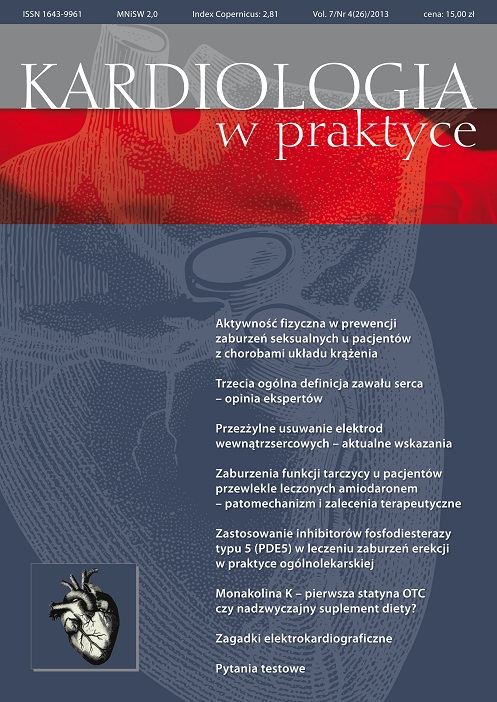Zastosowanie inhibitorów fosfodiesterazy typu 5 (PDE5) w leczeniu zaburzeń erekcji w praktyce ogólnolekarskiej Artykuł przeglądowy
##plugins.themes.bootstrap3.article.main##
Abstrakt
Zaburzenia erekcji, definiowane jako niezdolność do uzyskania i utrzymania wzwodu wystarczającego do odbycia stosunku seksualnego, dotyczą ok. 150 milionów mężczyzn. Przewiduje się, że do 2025 r. liczba ta zwiększy się do blisko 300 milionów. Zaburzenia erekcji mają związek z czynnikami ryzyka choroby sercowo-naczyniowej, a nawet przyjmuje się, że stanowią ekwiwalent choroby wieńcowej. Do doustnej terapii zaburzeń erekcji wprowadzono w 1998 r. inhibitory fosfodiesterazy typu 5, które stały się lekami pierwszego wyboru w leczeniu ZE. Inhibitory fosfodiesterazy typu 5 (PDE5) zwiększają stężenie cyklicznego monofosforanu guanozyny (cGMP) w komórkach śródbłonka naczyniowego ciał jamistych. Cykliczny monofosforan guanozyny pełni funkcję drugiego przekaźnika relaksacji naczyń zapoczątkowanej przez uwalnianie tlenku azotu. Zahamowanie aktywności fosfodiesterazy typu 5 powoduje wzrost stężenia cGMP i napływ krwi do zatok ciał jamistych. Obecnie w leczeniu zaburzeń erekcji stosuje się trzy inhibitory PDE5: sildenafil, wardenafil i tadalafil. Wyniki wielu badań klinicznych wskazują, że leki te są bezpieczne i skuteczne w leczeniu zaburzeń erekcji.
Pobrania
##plugins.themes.bootstrap3.article.details##

Utwór dostępny jest na licencji Creative Commons Uznanie autorstwa – Użycie niekomercyjne – Bez utworów zależnych 4.0 Międzynarodowe.
Copyright: © Medical Education sp. z o.o. This is an Open Access article distributed under the terms of the Attribution-NonCommercial 4.0 International (CC BY-NC 4.0). License (https://creativecommons.org/licenses/by-nc/4.0/), allowing third parties to copy and redistribute the material in any medium or format and to remix, transform, and build upon the material, provided the original work is properly cited and states its license.
Address reprint requests to: Medical Education, Marcin Kuźma (marcin.kuzma@mededu.pl)
Bibliografia
2. Bancroft J.: Seksualność człowieka. Elsevier, Wrocław 2011.
3. McKinlay J.B.: The worldwide prevalence and epidemiology of erectile dysfunction. Int. J. Impot. Res. 2000; 12: S6-S11.
4. Ayta I.A., McKinlay J.B., Krane R.J.: The likely worldwide increase in erectile dysfunction between 1995 and 2025 and some possible policy consequences. BJU Int. 1999; 84: 50-56.
5. Haczynski J., Lew-Starowicz Z., Darewicz B. et al.: The prevalence of erectile dysfunction in men visiting outpatient clinics. Int. J. Impot. Res. 2006; 18: 359-363.
6. Feldman H.A., Goldstein I., Hatzichristan D.G. et al.: Impotence and its medical and psychosocial correlates: results of the Massachusetts Male Aging Study. J. Urol. 1994: 151: 54-61.
7. Lee J., Ngwengwe R., Jones P.: Erectile dysfunction as a coronary disease risk equivalent. Journal of Nuclear Cardiology 2008; 15(6): 800-3.
8. Katazensin L.: Viagra(sildenafil citrate). The Remarkable Story of The Discovery and Launch. Medical Information Press, New York 2001.
9. DeBusk R., Drory Y., Goldstein I. et al.: Management of sexual dysfunction in patients with cardiovascular disease: recommendations of the Princeton Consensus Panel. Am. J. Cardiol. 2000; 86: 175-181.
10. Nehra A., Jacson G., Rosen R. et al.: The Princeton III Consensus recommendations for the management of erectile dysfunction and cardiovascular disease. Mayo Clin. Proc. 2012; 87(8): 766-778.
11. Viagra (sildenafil) Charakterystyka Produktu Leczniczego, 17.04.2013.
12. Padma-Nathan H., Giuliano F.: Oral drug therapy for erectile dysfunction. Urol. Clin. North Am. 2000; 321: 499-503.
13. Ralph D., McNicholas T.: UK management guidelines for erectile dysfunction. BMJ 2000; 321: 499-503.
14. Mittleman M.A., Glasser D.B., Orazem J.: Clinical trials of sildenafil citrate (Viagra) demonstrate no increase in risk of myocardial infarction and cardiovascular death compared with placebo. Int. J. Clin. Pract. 2003; 57: 597-600.
15. Mittleman M.A., Maclure M., Glasser D.B.: Evaluation of acute risk for myocardial infarction in men treated with sildenafil citrate. Am. J. Cardiol. 2005; 96(3): 443-446.
16. Giuliano F., Jackson G., Montorsi F. et al.: Safety of sildenafil citrate: review of 67 double-blind placebo-controlled trials and the postmarketing safety database. Int. J. Clin. Pract. 2010; 64(2): 240-255.
17. Padma-nathan H., Eardley I., Kloner R.A. et al.: A 4-year update on the safety of sildenafil citrate (Viagra). Urology 2002; 60(2, Suppl. 2): 67-90.
18. Mittleman M.A., Maclure M., Lewis M.A. et al.: Cardiovascular outcomes among sildenafil users: results of the International Men’s Health Study. Int. J. Clin. Pract. 2008; 62: 367-373.
19. Levitra. Charakterystyka produktu leczniczego.
20. Axilrod A.: Phosphodiesterase type 5 inhibitor therapy: identifying and exploring what attributes matter more to clinicans and patients in the management of erectile dysfunction. Curr. Med. Res. Opin. 2007; 23(12): 3189-3198.
21. Lietz T.: Wardenafil – doświadczenie kliniczne. Przegląd Seksuologiczny 2008; 16: 22-26.
22. Ahlen H., Zumie J., Stauch K., Hanisch J.: The real-life safety and efficacy of vardenafil (REALISE) study: results in men from Europe and overseas with erectile dysfunction and cardiovascular or metabolic condition. J. Sex. Med. 2010; 7(9): 3161-9.
23. Carson C.: PROVEN. Int. J. Imp. Res. 2003; 15(supl. 5): S162-S181 (streszczenie 31).
24. Cialis. Charakterystyka produktu leczniczego.
25. Rosen R., Shabsing R., Kuritzky L. et al.: The efficacy of tadalafil in improving sexual satisfaction and overall satisfaction in men with mild, moderate, and severe erectile dysfunction: a retrospective pooled analysis of data from randomized, placebo-controlled clinical trials. Curr. Med. Res. Opin. 2005; 21(11): 1701-1709.
26. Donatucii C., Wong D., Giuliano F. et al.: Efficacy and safety of tadalafil once daily: considerations for the practical application of a daily dosing option. Med. Res. Opin. 2008; 24(12): 3383-3392.
